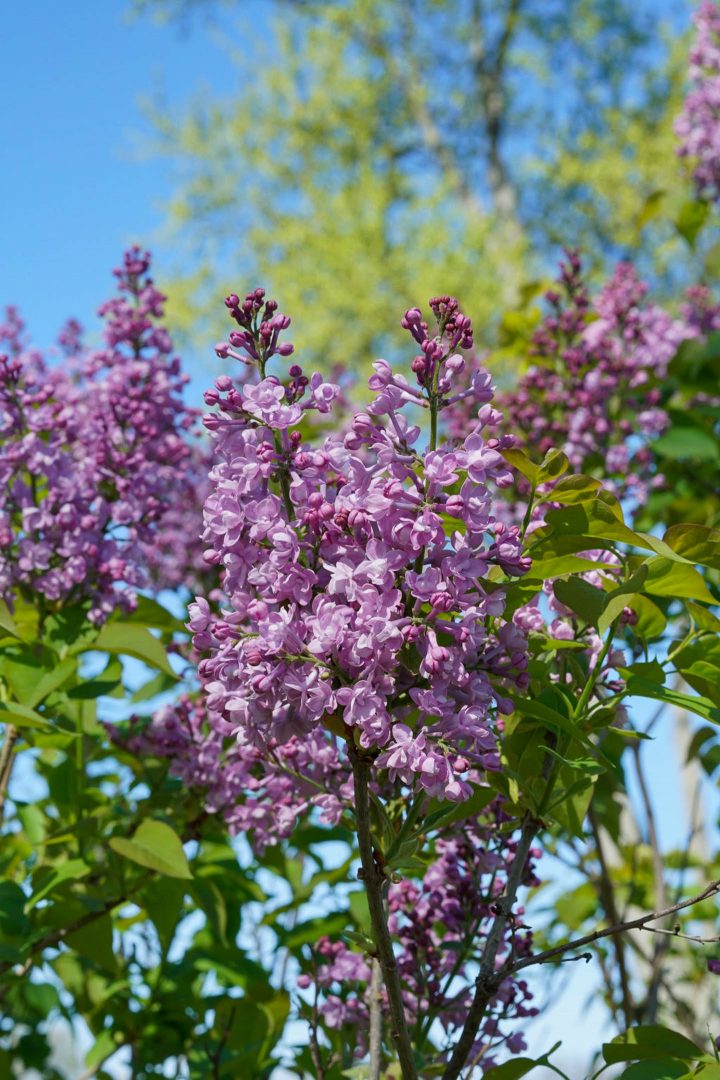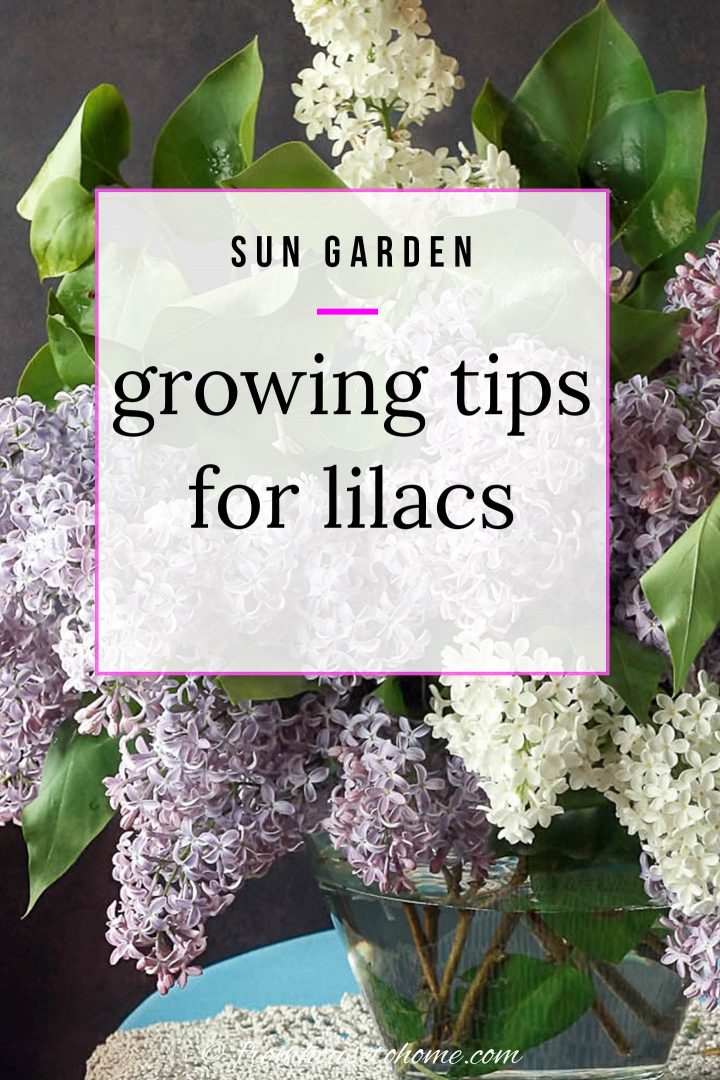How to Grow Lilacs: Spring’s Most Fragrant Flower
A classic flower, lilacs have withstood the test of time and remain one of the most gorgeous and sought-after spring flowers. Learning how to grow lilacs is simple as they require very little maintenance once established. Year after year, they will become one of your favorite parts of spring.

Lilacs (Syringa) are one of my absolute favorite bushes!
With their gorgeous blooms and beautiful scent, it's hard not to love them. They are an outstanding focal point in the spring garden.
A sunny day will enhance the perfume and attract pollinators to your garden. And maybe even a neighbor or two!
Lilacs are also a very durable plant, with some living to be more than 100 years old. So if you notice a lilac bush growing wild along a country road, it could be an indicator of an old homestead. Isn’t it amazing that lilacs can last longer than the homes?
I've gathered all of my best tips on how to grow lilacs in case you love them as much as I do.
Here's what we're going to cover (click the links if you want to skip to a specific section):
All About Lilacs

Before we talk about how to grow lilacs, let’s learn a little bit more about the history and what to expect from these beauties.
History
Native to eastern Europe and parts of Asia, lilacs made their way over to America in the 17th century. In fact, both George Washington and Thomas Jefferson included lilacs in their personal gardens.
Lilacs also take part in Greek mythology. It is said that while Pan was chasing the nymph, Syringa, through the woods, she hid herself by turning into a lilac. Pan found her, taking a piece of the plant, and using it to create the first panpipe. The name syringa is derived from the Greek word for pipe “syrinks” which is where the scientific name for lilac, Syringa, also comes from.
Zones
Common lilacs typically grow in zones 4-7.
However, you can find some varieties that will grow further south (all the way down to zone 9), such as Lavender Lady, Blue Skies, and Angel White.
And some that will grow further north (all the way up to zone 2) such as the Scentara Double Blue Lilac.
Check the tag of the lilac bush you are buying to ensure it grows well in your area.
Flower Colors

Of course, the color named “lilac” stems from the beautiful pastel purple most commonly seen in lilac flowers.
But you can also find lilacs in varying shades of purple, pink, red, white, yellow, and even the occasional blue (ish).
When Do Lilacs Bloom?
You will find lilac plants in bloom for a few glorious weeks in spring.
The most common varieties tend to flower for two weeks during the month of May.
However, different varieties will bloom at different times, with some blooms lasting as long as six weeks.
Size
Lilacs typically grow 12 to 18 inches a year until they reach their mature height, which can range from as small as 4 feet high to 20 or 30 feet tall.
You may be noticing a trend here…but different varieties will produce different sized lilac bushes.
Pollinators

The smell and beauty of lilac flowers are intoxicating – but not just to us!
You will soon notice how much the bees, butterflies and hummingbirds enjoy drifting through the lilacs, too.
By the way, here is a great list of other fragrant flowers to help attract beneficial pollinators to your yard.
How to Grow Lilacs


Zones: 2 to 9 (depending on the variety)
Light: Full Sun
Bloom Time: Spring
Height: 4 to 25 feet tall (depending on the variety)
Spread: 4 to 15 feet wide (depending on the variety)
Very rarely grown from seed, you will likely get your lilac from a nursery, garden center, or an offshoot from a friend’s own lilac shrub.
Follow these initial steps on how to plant lilac bushes and your plant will be healthy and established in no time.
Location
Where would you like your lovely lilac bush to grow?
Take a look at your garden and choose a location that has enough room for them to spread into.
Keep in mind the size of the variety you will be growing.
Their root system grows about 1 to 1 1/2 times the size of the plant and is not considered to be invasive. So there is no problem using them as a foundation plant next to the house.
Sunlight
Lilacs are full sun lovers. In order to get the best blooms possible, they need at least 6 hours of full sun.
If they receive too much shade, they may not bloom.
Soil
Lilacs prefer a slightly alkaline soil, ranging from a 6.5-7.0 pH. Doing a soil test before planting your shrub can be beneficial if you’re putting it in a new area.
Well drained soil works best, so don't plant them in an area with standing water.
While not their favorite growing conditions, they will tolerate clay if you mix in some compost or other organic matter when planting.
When To Plant Lilacs

The best time of year to plant a lilac bush is in late fall before the ground freezes. Alternatively, you can plant them in early spring after the ground has thawed and before the plant blooms.
Realistically, you will plant your lilac whenever the garden center has them in stock for you to purchase 🙂
Planting potted lilacs in the summer is okay too. They will just require more attention and watering to keep them healthy through the heat of the season.
How To Plant Lilacs
To plant your lilac bush, dig a hole a little deeper and wider than the nursery pot it came in.
Mix the soil you removed with some compost or triple mix. and put some of it back in the bottom of the hole.
Then place your lilac bush in. The top of the soil around the plant should be at the same level as it was in the container. If planted too deep, the lilac may drown or not bloom.
Water the bush well after planting. For the first year, water often to encourage root growth and ensure it does not wilt while getting established.
You can also apply a layer of mulch to help keep moisture in the soil and stop the weeds from growing. Be sure the mulch is a few inches away from the base stems to prevent them from rotting.
How to Care for Lilac Bushes
Once they are in the ground, the hard part is finished!
Learning how to care for lilacs only requires a few tips and tricks to encourage more blooms.
Watering
To be at their best, lilacs should get about 1 inch of water per week, especially during the hot summer months.
If you get that much rain, then no additional watering is necessary.
Having said that, once they are established lilacs are actually quite drought tolerant. They do much better with too little water than they do with too much.
Pruning Lilacs

Lilacs generally don't need much pruning.
It is more about maintaining shape and getting more flowers as opposed to part of their necessary care.
Deadheading Flowers
The most important aspect of pruning is deadheading the spent blooms.
This means removing the flower heads after they have finished blooming. Once your lovely lilac blooms have come and gone, get out there with some clean pruners and simply snip the flower head off, leaving the branches and leaves alone.
You want to do this immediately after they are done blooming. This will help the plant to focus its energy on preparing new buds for the spring. By the summer, the lilac is already making their flower buds for the next season and you don’t want to accidentally snip them off.
Deadheading also allows your lilac to maintain fullness and encourage more blooms as it doesn’t allow the lilac to set seed. Once a plant has set seed, it thinks its job is complete.
Shaping Lilacs
For mature plants, you may also want to consider shaping the bush.
Thinning a lilac every two to three years can help it maintain its shape and ensure it doesn’t get too big. Cut out any old wood, misshapen stems, or tall branches. Be careful not to take out more than a third of the plant.
For plants that have become too large, you can also cut them back. Keep in mind this may reduce blooming for the next year.
Each year, I also like to prune out any suckers. These are offshoots growing from the base of the plant. They tend to take energy from the main shrub and also interfere with its shape.
If you have inherited a neglected lilac that is overgrown and doesn’t flower much, you will need to give the plant an overhaul. This is a three-year process.
The first year, you will want to start by cutting one third of the shrub right to the ground. Then repeat the process with the next third of the bush the second year. Finally, finish cutting down the rest of the branches the third year. By then the lilac should be well shaped and blooming like crazy.
Fertilizing Lilacs
In addition to not needing much pruning, an established lilac also does not need much fertilizer.
In fact, too much fertilizer can encourage too much leaf growth and prevent the shrub from blooming.
Instead of fertilizer, I prefer to spread a layer of compost around the base of the plant in the spring to help it along.
However, if you want to use fertilizer, one application in the spring is generally all your lilac shrub will need. Once the plant is out of dormancy but before it has bloomed, apply a balanced fertilizer to the shrub. (To know if it is out of dormancy, look for flower buds forming.)
If you live in an area with acidic soil (like I do), sprinkling some lime on the soil after it has finished blooming will help it set better flowers for next year.
Common Pest Problems
A fairly hardy shrub, lilacs have very few pest problems. Even deer don't like them much!
Slugs
For young shrubs, slugs can be a nuisance.
If your plant has lots of holes in the leaves, this is likely the problem.
Sprinkling Sluggo* around the bottom of the plant will help to deter them.
Powdery Mildew
Powdery mildew is the most common issue found with mature lilacs.
It is a fungal disease that covers the plant in a grey or white powder.
Relatively harmless, powdery mildew is more of a nuisance than anything. It just doesn't look very good.
However if you're worried about it, the best way to treat powdery mildew is with prevention:
- Buy mildew resistant varieties (‘Miss Kim', ‘Sensation', and ‘Old Glory' are a few good options).
- Make sure the plant has good air circulation. Pruning out a few of the inner branches can help.
- Cleaning up leaves and debris around the base of the plant in the fall will prevent mildew spores from over-wintering and infecting the plant in the spring.
Lilac Varieties
There are more than 1,000 lilac varieties.
The most popular lilacs come from the family, Syringa vulgaris, which can be found in purple and white colors and grow to around 20 feet.
But if you look carefully, you can find some special varieties with different characteristics than the traditional lilac.
Many of these have been bred to thrive in different climates, which is great news if you live in a warmer zone (like I do) or a colder one where the common lilac varieties don't survive.
These are some of my favorites.
Scentara® Double Blue Lilac

Zones: 2 to 8
Height: 6′ to 8′
Spread: 6′ to 8′
With its double flowers, beautiful fragrance and super cold tolerance (zone 2!!), the Scentara® Double Blue lilac checks a lot of boxes!
The buds start out as a deep purple and lighten as they open to a light blue-purple color.
‘Miss Kim' Dwarf Korean Lilac (Syringa pubescens subsp. patula ‘Miss Kim')

Zones: 3 to 8
Height: 6′ to 7′
Spread: 5′ to 6′
Miss Kim is a dwarf Korean Lilac that grows smaller than most standard lilacs so it's a great choice if you don't have much space.
It also has flowers that come out later than most other varieties, so if you're looking to extend the lilac blooming season, this may be the one for you!
Miss Kim also has the best fall foliage color of any of the lilac bushes.
Bloomerang® Series

Zones: 3 to 8
Height: 3′ to 5′
Spread: 3′ to 5′
The Bloomerang lilacs are a new variety that reblooms (that means lilacs all season!). It puts on a big show in the spring and then produce sporadic flowers throughout the rest of the season
Available in both purple and pink as well as dwarf versions, they don't grow as large as the standard French lilacs. So another great choice for a small space.
‘Sensation' Lilac (Syringa vulgaris ‘Sensation')

Zones: 3 to 7
Height: 8′ to 10′
Spread: 8′ to 12′
Winner of the Royal Horticultural Society Award of Garden Merit, Sensation Lilac has bi-colored fragrant blooms that are a beautiful purple-red color edged with white.
Even better? They can last for almost a month!
It's a member of the Syringa vulgaris family so plant it in a location that fits the size.
‘Beauty of Moscow' Lilac (Syringa vulgaris ‘Krasavitsa Moskvy')

Zones: 3 to 7
Height: 10′ to 12′
Spread: 8′
The ‘Beauty of Moscow' lilac has buds that start out as a light pink or purple, then open at different times into beautiful double white flowers.
The mix of purple, pink and white against the green leaves is absolutely gorgeous!
Enjoying Indoors

With such a beautiful fragrance, you will almost certainly want to bring some of your lilac blooms indoors!
For Bouquets
Once cut, lilac blooms won’t open much more. Look for a head of blooms that has at least 1/3 of their flowers open.
Cut enough stem so you can easily arrange it inside a vase. For the health and beauty of the parent plant, cut right after a node, where the leaves grow out from the stem.
Forcing
You can even enjoy lilacs a few weeks early by forcing indoor blooms.
Choose branches with lots of buds and cut an x into the bottom of the stem. This will help the lilac take in water more quickly.
Let the stems soak up cold water overnight, then transfer to warm water with floral preservative in it.
You will have indoor blooms anywhere from one to four weeks, depending on the maturity upon clipping.
And that’s everything there is to know about how to grow lilacs! I hope you have learned something new about the shrub and are just excited for their spring blooms as I am.
Where To Buy Lilacs Online
These are my favorite online nurseries for lilacs:
- Planting Tree* – They have a limited selection of lilacs but their plants are really healthy, always shipped in containers, and arrive right when they say they will.
- Nature Hills* – This nursery has a larger selection of lilac varieties and gives you the choice of what size you want as well as whether to ship the plants bareroot or in containers. However, they are a little more expensive.
- Home Depot* – Believe it or not, Home Depot's online store has a surprising number of lilac varieties (that are not available in their stores). Some are sold bareroot and some as plants so be sure to read the descriptions. The plants are usually smaller than the other two options, but they're also less expensive.
More Flower Guides
- How to Start a Flower Garden
- Clematis Guide: the Ultimate Guide to Planting, Growing, and Pruning Clematis
- Spring Flower Combinations: 8 Beautiful Plantings to Try
- Hellebore Care and Planting Guide
Have any more questions about your new or old lilac plant? Drop a comment below and I’d be happy to answer it!
Pin It So You Don't Forget It!

This post was originally published on March 15, 2021 but was updated with new content on November 23, 2024.





















